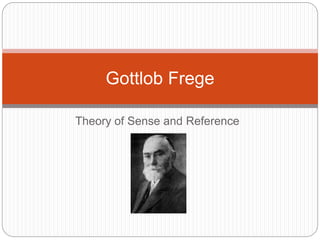
Gottlob Frege's Sense and Reference
- 1. Theory of Sense and Reference Gottlob Frege
- 2. Frege’s puzzle: “The Puzzle About Identity” How can ‘a=a’ convey anything different from ‘a=b’? What treatment of identity statements will explain the difference? Frege’s two view of identity: (1) Identity is a relation between objects (2) Identity is a relation between names (or signs) of objects
- 3. Frege favors #2 (identity is a relation between names (or signs). Why? E.g. : ‘a=a’ (Hesperus=Hesperus) known a priori ‘a=b’ (Hesperus=Phosphorus) cannot be known a priori The difference between two such statement is a difference in their cognitive value. The difference is unaccountable if identity is a relation between objects since both statements alike would only record the fact that some thing is the same as itself. It seems that something is learned from an identity statement because it is learned through the difference of the two names, hence, what the statement really tells us about is a relation between names.
- 4. Or isn’t the view of identity as a relation between signs no better than the view of it as a relation between objects? Why? If we take identity statements to speak merely about names, then the cognitive difference between the statements that Hesperus=Hesperus and that Hesperus=Phosphorus would not be apparent. We do not wish to show just the difference of names, but the meaning. Any sign can be used and this could not convey the sort of knowledge expressed in Hesperus=Phosphorus.
- 5. ‘a=b’ is both informative and true Informative: the difference between ‘a’ and ‘b’ in respect of how they present the objects that they name—a difference in their mode of presentation; thus, a certain object may be presented in different ways according to such a difference can explain the difference in cognitive value; ‘a’ and ‘b’ differ in sense True: ‘a=b’ where ‘a’ and ‘b’
- 6. The Problem having the informative aspect solely: incorrect picture of the whole Blind men and the Elephant
- 8. The Problem with looking at the ‘truth’ aspect solely: lack of depth and richness of reality “A bachelor is unmarried.” No new learning, no other aspect seen, no richness in perspective
- 9. Do you agree with Frege that ‘Hesperus is Phoshorus’ conveys proper knowledge which is not covered by saying that the names ‘Hesperus’ and ‘Phosphorus’ refer to the same thing? ‘metalinguistic account’: identity as a relation between names We talk about the Hesperus not about the name Hesperus when we say it is the same as Phosphorus Hesperus=Phosphorus is true only if we talk about the same thing and that the name refers
- 10. Sign: name, combination of words, letter Reference: that to which the sign refers Sense: the mode of presentation “point of intersection of a and b” and “the point of intersection between b and c” >sign: different >reference: the same >sense: different
- 11. “Proper Name” By ‘sign’ and ‘name’ : any designation representing a proper name which thus has as its reference a definite object Can also consist of several words or other signs For brevity, every such designation will be called proper name the sense of a proper name is grasped by everybody who is sufficiently familiar with the language or totality of designations to which it belong e.g. “Aristotle” Senses: “the pupil of Plato” “the teacher of Alexander the Great”
- 12. Regular connexion between a sign, its sense and its reference To the sign there corresponds a definite sense and to that in turn a definite reference (an object) while to a given reference (an object) there does not belong only a single sign The same sense has different expression in different languages or even in the same
- 13. Exception to this regular connexion 1.To a sense, there may not be a corresponding reference: e.g. “the celestial body most distant from the Earth” “the least rapidly convergent series” 2. “signs of signs”: when words of another are quoted
- 14. Frege vs. Locke Reference/sense Idea Reference is an object perceivable by the senses An internal image arising from the memories of sense impressions which I have had and acts, both internal and external which I have performed Not saturated with feelings Saturated with feelings; The clarity of its separate parts remains the same The clarity of its separate parts varies and oscillates Sign’s sense: common property of many; not part of a mode of the individual mind (mankind has a common store of thoughts passed from one generation to another) Subjective: different persons will have a variety of differences in the idea associated with the same sense Two persons can grasp the same sense. Si duo idem faciunt, non est idem (If two persons picture the same thing, each still has its own idea.)
- 15. Frege’s analogy of sense vs. idea: “observing the Moon through a telescope” Reference: Moon Sense: real image projected by the object glass in the interior of the telescope (optimal image is dependent upon the standpoint of the observation but it is still objective) Idea or experience: the retinal image of the observer (diverse shapes of the observer’s eyes will cause his own retinal image)
- 16. 3 levels of difference between words/expression or sentences: 1. Difference in ideas (different persons will have different ideas given a particular word; will also cover “coloring and shading”) 2. Difference in sense but not reference 3. Difference in reference Conclusion: A proper name (word, sign, sign combination, expression) expresses its sense, stands for or designates its reference. By means of a sign we express its sense and designate its reference.
- 17. Assignment: 1. Compare and Contrast Mill and Frege’s treatment of Proper Names 2. Read Wittgenstein’s Philosophical Investigations Mill Frege
